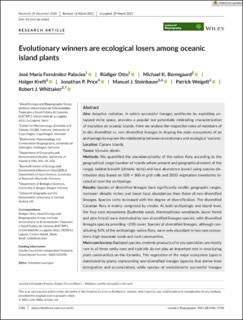| dc.description.abstract | Aim
Adaptive radiation, in which successful lineages proliferate by exploiting untapped niche space, provides a popular but potentially misleading characterization of evolution on oceanic islands. Here we analyse the respective roles of members of in situ diversified vs. non-diversified lineages in shaping the main ecosystems of an archipelago to explore the relationship between evolutionary and ecological ‘success’.
Location
Canary Islands.
Taxon
Vascular plants.
Methods
We quantified the abundance/rarity of the native flora according to the geographical range (number of islands where present and geographical extent of the range), habitat breadth (climatic niche) and local abundance (cover) using species distribution data based on 500 × 500 m grid cells and 2000 vegetation inventories located all over the archipelago.
Results
Species of diversified lineages have significantly smaller geographic ranges, narrower climatic niches and lower local abundances than those of non-diversified lineages. Species rarity increased with the degree of diversification. The diversified Canarian flora is mainly comprised by shrubs. At both archipelagic and island level, the four core ecosystems (Euphorbia scrub, thermophilous woodlands, laurel forest and pine forest) were dominated by non-diversified lineages species, with diversified lineages species providing <25% cover. Species of diversified lineages, although constituting 54% of the archipelagic native flora, were only abundant in two rare ecosystems: high mountain scrub and rock communities.
Main conclusions
Radiated species, endemic products of in situ speciation, are mostly rare in all three rarity axes and typically do not play an important role in structuring plant communities on the Canaries. The vegetation of the major ecosystem types is dominated by plants representing non-diversified lineages (species that derive from immigration and accumulation), while species of evolutionarily successful lineages are abundant only in marginal habitats and could, therefore, be considered ecological losers. Within this particular oceanic archipelago, and we posit within at least some others, evolutionary success in plants is accomplished predominantly at the margins. | en_US |

